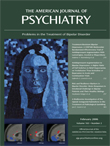Research into suicide is increasing so rapidly that a new textbook summarizing the field is needed every few years; simply updating the last such volume will not do. The current volume, edited by Robert Simon and Robert Hales and featuring a distinguished group of contributors, is a more than worthy successor to comparable past textbooks on suicide. Intended for the practicing clinician, it provides important new insights and perspectives.
Robert Simon’s introductory chapter, “Suicide Risk: Assessing the Unpredictable,” is a thorough explication of the possibilities and limitations of suicide risk assessment. The subsequent individual chapters present an up-to-date, comprehensive treatment of almost every aspect of suicide risk assessment: age, gender, social and cultural factors, psychiatric diagnosis, prevention, treatment setting, and type of treatment. Simon and Hales also include special subjects ranging from murder-suicides to the aftermath of suicide not only for family survivors but also for psychiatrists who had been treating patients who killed themselves.
Virtually every chapter offers information that is helpful in understanding and treating affected patients. Most of the chapters attempt to translate advances in our knowledge through research into practical information that the clinician can use. The chapters that achieve this best are outstanding, such as Jan Fawcett’s chapter on assessing suicide risk in depressed patients.
Fawcett draws on recent research to present clinicians with a guide to evaluating acute suicide risk in depressed patients even when they deny suicide intent. Prospective and retrospective studies of suicides and suicide attempts have shown that factors associated with high acute suicide risk in patients with affective disorders include an agitated state, severe psychic anxiety, severe panic attacks, severe or global insomnia, and severe anhedonia
(1–
4). When Fawcett cites specific research, he puts it into a meaningful context so that the reader comes away with an understanding of why these factors need to be considered in evaluating a patient who may be at acute risk for suicide.
The chapter by Yeates Conwell on suicide in the elderly is equally memorable. Conwell weaves essential facts and reasonable interpretations of what they mean into a remarkably clear, informative, and readable summary of what we know and still need to learn about suicide among the elderly.
Excellent case illustrations are the other outstanding feature of this book. Cases in the evaluation and treatment sections of the book rise past the usual vignettes, which reduce the patient to a single point that the author wishes to make. Instead, they provide rich detail and engage and educate the reader at the same time. For example, Florence Kim, Lauren Marangell, and Stuart Yudofsky present a case demonstrating that ECT not only may be indicated at times but also may be the only effective treatment available for some patients.
Being comprehensive is not always a virtue. The book could have used more editing. A few chapters, unlike those cited, seem unselective in the research described, do not put the findings into any meaningful context, and read more like research compendiums than chapters in a book. There is also a troubling repetition of the same epidemiological material by several authors. The editors are cognizant of this, and in the preface to the book they unpersuasively attempt to justify such repetition by saying that they do not expect their readers to read every chapter but, rather, to select chapters that interest them. Cross-referencing the relevant data might have met the needs of such readers while not affecting those who want to use the book to gain a broader overview of the field.
These caveats aside, the Simon and Hales textbook has set a high standard that future books will have to meet. I enjoyed, learned from, and was stimulated by reading this fine volume.

